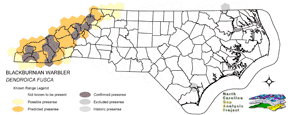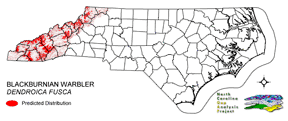
| Taxa: |
| Order: |
| Family: |
| Aves |
| Passeriformes |
| Parulidae |
| NatureServe Global Rank: |
| NatureServe State (NC) Rank: |
| G5 |
| S4B,SZN |
| Federal Status: |
| NC State Status: |
| --- |
| --- |


| Land Unit |
| US Fish & Wildlife Service |
| US Forest Service |
| US National Park Service |
| US Department of Defense |
| NC State Parks |
| NC University System |
| NC Wildlife Res. Com. |
| NC Forest Service |
| NC Div. of Coastal Mgmt. |
| Local Governments |
| Non-Governmental Org. |
| Other Public Lands |
| Private Lands |
| GAP Status 1-2 |
| All Protected Lands |
| Statewide |
| Hectares |
| 0.00 |
| 190,066.23 |
| 22.59 |
| 79,617.96 |
| 2,276.55 |
| 66.60 |
| 3,162.15 |
| 651.06 |
| 0.00 |
| 5,034.69 |
| 5,280.21 |
| 8.73 |
| 331,372.62 |
| 109,970.55 |
| 286,030.89 |
| 617,559.39 |
| Acres |
| 0.00 |
| 469,663.79 |
| 55.82 |
| 196,740.23 |
| 5,625.48 |
| 164.57 |
| 7,813.84 |
| 2,453.46 |
| 0.00 |
| 12,440.99 |
| 13,047.68 |
| 21.57 |
| 818,839.42 |
| 272,587.75 |
| 707,642.24 |
| 1,526,866.84 |
| % of Dist. on |
| Prot. Lands |
| 0.0 % |
| 66.4 % |
| 0.0 % |
| 27.8 % |
| 0.8 % |
| < 0.1 % |
| 1.1 % |
| 0.2 % |
| 0.0 % |
| 1.8 % |
| 1.8 % |
| < 0.1 % |
| 0.0 % |
| 38.4 % |
| ----- |
| ----- |
| % of Dist. on |
| All Lands |
| 0.0 % |
| 30.8 % |
| < 0.1 % |
| 12.9 % |
| 0.4 % |
| < 0.1 % |
| 0.5 % |
| 0.1 % |
| 0.0 % |
| 0.8 % |
| 0.9 % |
| < 0.1 % |
| 53.7 % |
| 17.8 % |
| ----- |
| ----- |
|
Breeds only in the middle to high elevations of the mountain region (Pearson 1959, Potter et al. 1980). Declining due to decrease in mature fir trees in the Great Smoky Mountains National Park (Alsop and Laughlin 1991) and on Mount Mitchell (McNair 1987). Probably absent from Roan Mountain due to intense logging in the 1930s (Nicholson 1997). At high elevations, found in mature and advanced second growth (Curson et al. 1994) forests of tall spruce, fir, hemlock, and northern hardwoods (Potter et al. 1980, Dunn and Garrett 1997). Mature hemlock and mixed hemlock-deciduous forests may be optimal habitat (Nicholson 1997). At lower elevations ( to 3000 feet), can be found in mature deciduous forests and in oak-hickory-pine dominated areas (Dunn and Garrett 1997). Nest placed 5-80 (average of 30) feet above ground in a conifer, often a hemlock or spruce, 6-10 feet from the trunk on, or sometimes on the tip of, a horizontal limb (Potter et al. 1980, Dunn and Garrett 1997). Forages high in conifers and hardwoods, with males tending to forage higher than females (Ehrlich et al. 1988). NATURE SERVE GLOBAL HABITAT COMMENTS: Coniferous (primarily balsam fir or hemlock) and mixed forest, open woodland, second growth. In Upper Michigan, breeds in natural, older age (60-167 years old), pole, and sawlog size-class stands on mesic upland sites, with canopy closure averaging 80% and basal area of conifer trees about three times greater than that of hardwoods (Doepker et al. 1992). MIGRATION: in various forest, woodland, scrub, and thicket habitats (AOU 1983). NON-BREEDING: forests and woodlands of mountain slopes; forest canopy and edge, semi-open areas, tall second growth (Stiles and Skutch 1989). BREEDING: Nests on horizontal branch of conifer, well out from trunk, in site well concealed by foliage or lichen, 2-24 m above ground. NATURE SERVE STATE HABITAT COMMENTS: Fairly common breeder in Southern Appalachians above 1050 m; occurs down to 480 m elevation (Hamel 1992). |
| Code | Name | Description | NC Natural Heritage Program Equivalent |
| 517 | Hemlock Floodplain Forest | Alluvial forest with hemlock and/or white pine in mountains and western piedmont. Hydrology is generally temporarily to seasonally flooded. | Canada Hemlock Forest |
| 521 | Spruce/Fir Forest | High Elevation Frazer-Fir - Red Spruce, Red Spruce and Red-Spruce-Yellow Birch Forests. Tree densities included here include both woodland to forest density. Highly intermixed with Northern Hardwoods, Grassy Balds, and Shrub Balds. | Red Spruce--Fraser Fir Forest, Fraser Fir Forest |
| 522 | Northern Hardwoods | High Elevation forests including yellow birch, American beech, and yellow buckeye. Includes forests with Hemlock and Yellow Birch. | Northern Hardwoods Forest, Boulderfield Forest |
| 525 | Appalachian Oak Forest | A variety of oak forest types including Black, White, Scarlet Oaks in dry to mesic situations. Includes forests historically co-dominated by American Chestnut. | High Elevation Red Oak Forest, Montane White Oak Forest |
| 526 | Appalachian Cove Forest | Mixed Mesophytic forests of the mountains. Includes tuliptree, basswood, yellow buckeye and surgar maple. This class is mapped to include cove forests dominated or co-dominated by hemlock. | Rich Cove Forest, Acidic Cove Forest |
| 527 | Appalachian Hemlock | Upland hemlock forests of the moutains region. Vary from side slopes to steep slope positions. | Canada Hemlock Forest |
| 528 | Appalachian Xeric Pine Forest | Pine forests and woodlands on xeric sites. A variety of pines, including Virginia, Shortleaf, Eastern White Pine, Table Mountain and Pitch pine. Often small areas of dense pine within a matrix of Xeric Oak-Pine Forests. | Pine Oak Heath |
| 530 | Appalachian Xeric Deciduous Forest | Deciduous forests in the mountains dominated by Xeric Oak species. Species include, white, Southern red, black, and rock chestnut. | High Elevation Red Oak Forest, Montane White Oak Forest |
|
Chipley, R. M. 1980. Nonbreeding ecology of the blackburnian warbler. Pages 309-317 in B80KEA02NA.
Alsop, F.J. III and T.F. Laughlin. 1991. Changes in the spruce-fir avifauna of Mt. Guyot, Tennessee, 1967-1985. Journal of the Tennessee Academy of Science 66:207-209. Bent, A.C. 1953. Life histories of North American wood warblers. U.S. Natl. Mus. Bull. 203. Washington, D.C. Hamel, P. B. 1992. The land manager's guide to the birds of the south. The Nature Conservancy, Chapel Hill, North Carolina. 367 pp + several appendices. Dunn, J.L., and K.L. Garrett. 1997. A field guide to warblers of North America. Houghton Mifflin Company, Boston. Nicholson CP. 1997. Atlas of the breeding birds of Tennessee. Knoxville: University of Tennessee Press. Pearson, T.G. 1959. Birds of North Carolina. Raleigh, NC: Bynum Printing Company. Harrison, C. 1978. A field guide to the nests, eggs and nestlings of North American birds. Collins, Cleveland, Ohio. Griscom, L., and A. Sprunt, Jr. 1979. The warblers of America. Doubleday and Co., Garden City, New York. 302 pp. Keast, A., and E. S. Morton. 1980. Migrant birds in the Neotropics; ecology, distribution, and conservation. Smithsonian Inst. Press, Washington, D.C. Potter, E. F., J. F. Parnell, and R. P. Teulings. 1980. Birds of the Carolinas. Univ. North Carolina Press, Chapel Hill. 408 pp. Terres, J.K. 1980. The Audubon Society encyclopedia of North American birds. Alfred A. Knopf, New York. American Ornithologists' Union (AOU), Committee on Classification and Nomenclature. 1983. Check-list of North American Birds. Sixth Edition. American Ornithologists' Union, Allen Press, Inc., Lawrence, Kansas. Harrison, H.H. 1984. Wood warblers' world. Simon and Schuster, New York. 335 pp. Ehrlich, P.R., D.S. Dobkin, and D. Wheye. 1988. The birder's handbook:a field guide to the natural history of North American birds. Simon and Shuster, Inc., New York. xxx + 785 pp. McNair, D. B. 1987. Egg data slips-are they useful for information on egg-laying dates and clutch size? Condor 89:369-76. Ridgely, R.S., and G. Tudor. 1989. The birds of South America. Vol. 1. The Oscine passerines. Univ. Texas Press, Austin. 516 pp. Stiles, F.G., and A.F. Skutch. 1989. A guide to the birds of Costa Rica. Comstock Publ. Associates, Cornell University Press, Ithaca, New York. 511 pp. Doepker, R.V., R.D. Earle, and J.J. Ozoga. 1992. Characteristics of blackburnian warbler, Dendroica fusca, breeding habitat in Upper Michigan. Canadian-Field-Naturalist 106: 366-371. |
For more information please contact them at:
NC-GAP Analysis Project
Dept. of Zoology, NCSU
Campus Box 7617
Raleigh, NC 27695-7617
(919) 513-2853
www.basic.ncsu.edu/ncgap